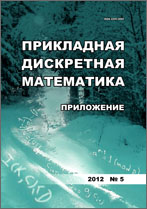|
|
Prikladnaya Diskretnaya Matematika. Supplement, 2014, Issue 7, Pages 75–76
(Mi pdma187)
|
 |
|
 |
Mathematical Methods of Steganography
Principles of associative steganography
I. S. Vershinin
Kazan State Technical University, Kazan
Abstract:
Data protection with the use of masking device which is used in two-dimensional associative processing of stylized binary images is considered to be used in the sphere of steganography. Applied to mapping, the suggested approach of stegoprotection has got an unconditional stability. The method which is under review belongs to the kind of probabilistic types of protection. Randomnicity is used with special mechanism of spatial clustering of objects masking their binary representations and randomization. The subject of protection is a set of thematic map-clusters as randomly generated (on local maps) tables in terms of “object-codes – coordinate-codes”. Protected thematic maps form the “upper layers” of geoinformation system. The original binary image is subjected to a selective effect of stochastic interference (randomization). Herewith, those parts of objects which are not affected by interference randomly selected from the fulfilment of certain conditions. But their precise knowledge (this is the main key) allows correctly to identify objects in general by the method of two-dimensional associative search. For key generation, a basic algorithm of masking is formed.
Keywords:
associative steganography, two-dimensional-associative masking, protection of the cartographical data.
Citation:
I. S. Vershinin, “Principles of associative steganography”, Prikl. Diskr. Mat. Suppl., 2014, no. 7, 75–76
Linking options:
https://www.mathnet.ru/eng/pdma187 https://www.mathnet.ru/eng/pdma/y2014/i7/p75
|

| Statistics & downloads: |
| Abstract page: | 168 | | Full-text PDF : | 132 | | References: | 34 |
|




 Contact us:
Contact us: Terms of Use
Terms of Use
 Registration to the website
Registration to the website Logotypes
Logotypes








 Citation in format
Citation in format 